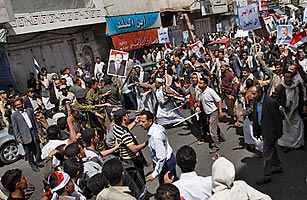
Supporters of the Yemeni government, right, clash with demonstrators demanding the resignation of President Ali Abdullah Saleh in Sana'a
Tahrir Square in Cairo was crucial to the protest movement that brought down Egypt's President Hosni Mubarak, a dethroning that sent tremors through a region full of long-sitting autocrats. Among them is President Ali Abdullah Saleh of Yemen, who has held power for more than three decades. His capital, Sana'a, also has a Tahrir Square — and the supporters of his regime, this time at least, are trying to put up a fight over who controls it.
Spurred by toppling of Mubarak, students in the Yemeni capital went out to demand the resignation of Saleh, who, barely two weeks before — already shaken by local demonstrations inspired by Egypt and Tunisia — had promised he would not seek a new term in the 2013 presidential elections. The demonstrations were a continuation of marches on Sunday, which had resulted in the arrest of seven students, according to the Students' Union of Sana'a University. Monday's march demanded their immediate release.
The protesting students were joined by delegates from the lawyers' union, political activists and many ordinary citizens. Estimated at about 4,000, the protesters marched from the Sana'a University campus to Tahrir Square. They carried signs condemning the regime and demanding that Saleh leave office. Among the signs: "Hey Ali, follow Mubarak," "Hey Ali, leave — the chair under you has rusted" and "No corruption after today."
In a pointed insult, the demonstrators also held aloft a photo of former President Ibrahim al-Hamdi, who was assassinated in 1977. Al-Hamdi is still widely revered in the country — and, indeed, by a generation that had yet to be born while he ruled. He had attempted to rid Yemen of tribal loyalties and had begun to make important social and political changes when he was killed. He is considered the best President to have ruled Yemen in the eyes of the majority of the Yemeni people. "We want to reach a better situation in Yemen. This can only be achieved by making changes," says Bandar al-Samawi, one of the antigovernment marchers. "We will respect personal property; this will be a peaceful revolution."
However, when the protesters reached Tahrir Square, they found more than 1,000 pro-government demonstrators already camped out there, loudly proclaiming their support for the regime and for President Saleh. The two sides then engaged in fights involving stones and sticks. The police used batons and sticks to keep the dueling groups apart. According to eyewitnesses, plainclothes cops turned up among the marchers as well, using sticks to beat the protesters. The police set up an electrified, barbed-wire fence to keep the antiregime protesters from moving on, attacking them with Tasers as well. Demonstrators for and against Saleh were injured, as well as a reporter for the BBC.
The antigovernment marchers were pushed back to the Sana'a University campus and the demonstration gradually broke up. Afterward, the students issued a press release to condemn what they called the "barbaric reaction by the regime." The statement also declared that the students will continue their "holy revolution" and invited the rest of the Yemeni people to join them.
The clashes between pro-government groups and demonstrators — and the police's willingness to use Tasers and violence — has kicked up Yemen's answer to the Egyptian uprising by a notch or two. But the government's ability to counter protesters with a smaller, though still substantial, number of loyalists maintains the political stalemate in Yemen. Egypt's public outpouring of anger at Mubarak eventually overcame any loyalist gatherings the regime could muster. Yemen's anti-Saleh activists have a way to go before they can do that.